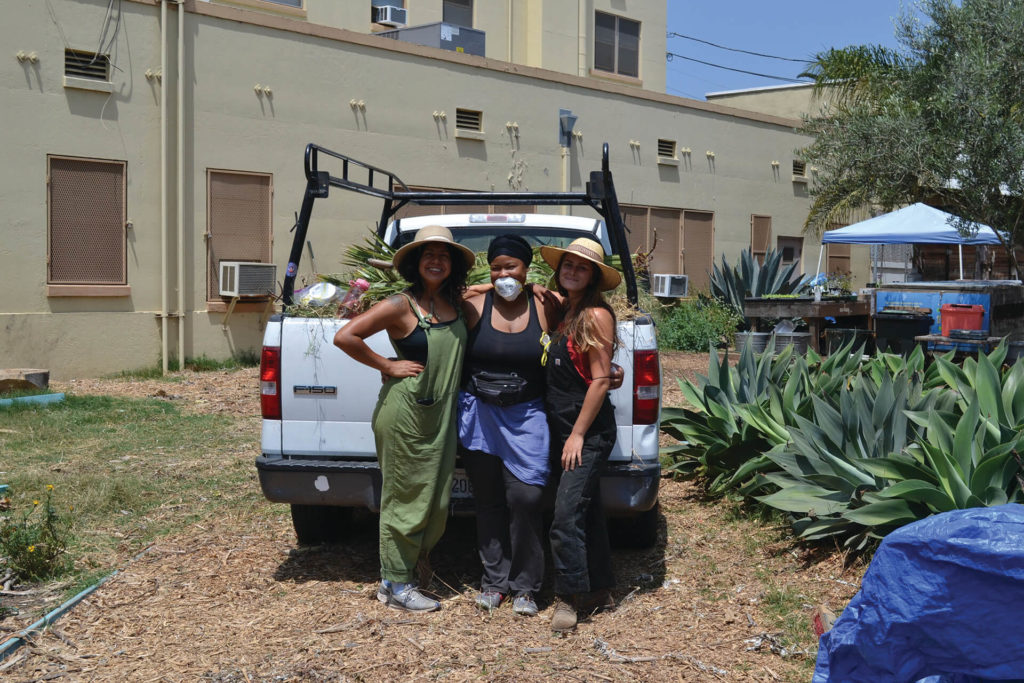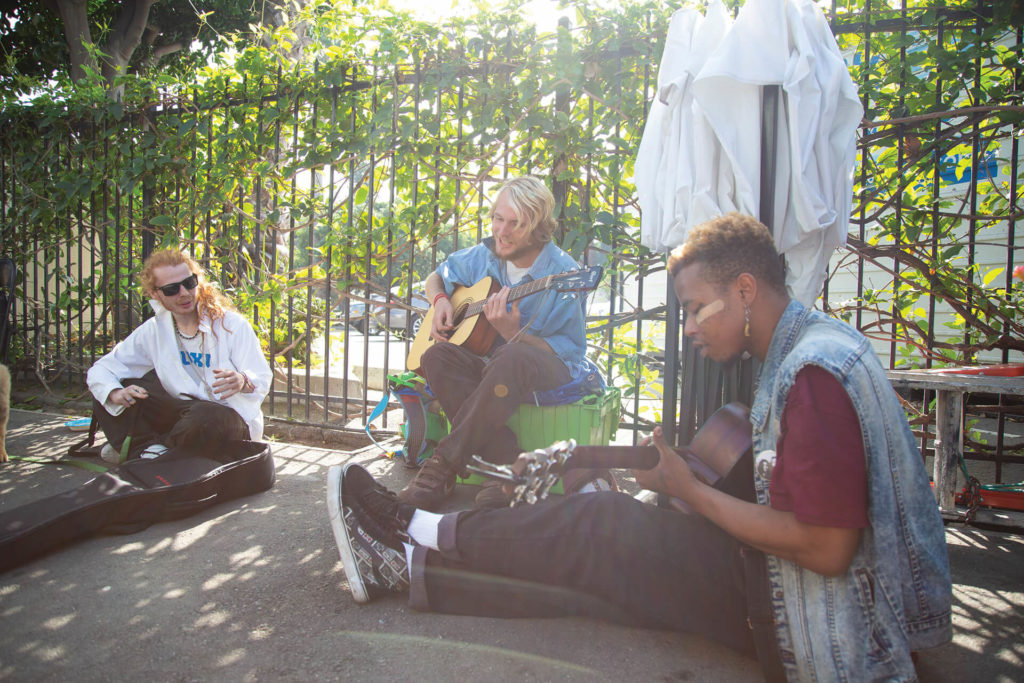With Open Arms
A VENICE-BASED NONPROFIT SEEKS TO RIGHT INEQUITY BY HELPING HOMELESS YOUTHS.

BY VICTORIA CLAYTON
The Community Impact Fund (CIF) was established by Saint John’s Health Center Foundation to support our local health care partners in improving the health of our community. Each year the CIF committee reviews applications and makes grants to entities striving to improve the health of local residents. In this issue of Saint John’s, we update readers on the ongoing problem of homelessness among young people, which has worsened during the COVID-19 pandemic.
To many people, the issue of homelessness among young people seems overwhelmingly complex. Not to Alison Hurst, executive director of Safe Place for Youth—a nonprofit that offers solutions for homeless and housing-insecure youths ages 12 to 25 and one of the recipients of the Saint John’s Health Center Foundation’s Community Impact Fund grant.
“It’s really simple,” says Hurst, who started the nonprofit with a group of volunteers more than a decade ago. “Homeless youths are just young people who are falling through society’s cracks.” And, she says, during the COVID-19 pandemic some of those cracks grew wider.
Safe Place for Youth aims to empower kids who are homeless—whether that means sleeping on the streets, on the beach, in a van or in a car, or couch-surfing—to create a healthy, sustainable future for themselves. Youths experiencing homelessness or home insecurity are welcomed with open arms and can receive a number of services including housing referrals, return home travel, case management, food, clothing, internet access, counseling, health education and screenings, dental services, pregnancy and parenting support, transportation, art and music groups, mail and phone services, and access to a legal clinic. Many people served by Safe Place for Youth are what Hurst describes as “system-involved.” That means they’ve been in foster care and/or the juvenile detention system.

“If you look a little deeper you see that so many are LGBTQ who have not been able to reside or remain supported by family members,” explains Hurst. In addition, many young people served by Safe Place for Youth are BIPOC (Black, indigenous, people of color). “I’d say that when you really look at it clearly, you find that historical and systematic racism and injustice are huge drivers of youth homelessness.” Whatever way you look at it, though, this is no small problem— even before the COVID-19 pandemic. Nationwide, an estimated 1.6 to 1.7 million youths join the ranks of those without a home each year. Last year in Los Angeles County, an estimated 4,673 youths experienced homelessness on any given night—a 19% increase from the previous year. Stats from the United States Interagency Council on Homelessness are consistent with what Hurst sees: 31% of homeless youths report current or previous involvement in the child welfare system, and 62% report previous or current involvement in the juvenile or criminal justice systems.
“It’s tragic. A shocking number of young people exit these systems without anyone helping them connect to safe and stable housing,” Hurst says. The COVID-19 pandemic has only complicated the outlook for youths who are homeless. Just prior to the COVID-19 shutdown, Safe Place for Youth in conjunction with the Westside nonprofit PATH (People Assisting the Homeless) opened Los Angeles’ largest bridge housing shelter for youths with a 154-bed capacity and 54 beds specifically for young people.
“ALMOST 30% OF HOMELESS YOUTHS IN THE U.S. ARE LIVING IN CALIFORNIA. 79% OF HOMELESS YOUNG PEOPLE IN CALIFORNIA ARE UNSHELTERED, MAKING THEM MORE VULNERABLE TO CONTRACTING AND SPREADING COVID-19.”

Before the opening, Westside homeless teens and young adults were referred downtown to Skid Row. Bridge housing is just what the name suggests—it provides a tool to get kids off the streets prior to locating permanent housing. It consists of dormitory-style living, and staff try to resolve the needs of residents and help them progress to the next, more stable stage.
If you don’t have your physical or mental health needs met, however, that’s unlikely to happen. Health care counselors are critical pieces of the puzzle, providing on-site support and arranging for young people to receive a variety of necessary medical care and therapeutic services. The most recent CIF grant from the Saint John’s Health Center Foundation allowed Safe Place for Youth to hire an onsite health care counselor for the new bridge housing unit. When the pandemic struck, the health care counseling position became integral to operations. Under typical conditions, many bridge housing residents would opt to come to Safe Place for Youth’s Access Center on Lincoln Boulevard in Venice to access services and activities during the day. With the pandemic in full swing, however, they had to stay on-site at the bridge housing unit, and the CIF grant-funded health care counselor became their lifeline.
Safe Place for Youth continued street outreach and other services, but the pandemic meant a temporary halt to the organization’s major fundraising events. The number of youths they were able to serve during the pandemic shutdown fell from 1,600 during the previous year to around 1,200.“Even under the circumstances, though, we didn’t miss a beat,” says Hurst, who notes they are now back up to full-service capacity. “Our staff didn’t have the luxury of sheltering at home. They showed up every single day to provide what we could. That’s why I always say that this field is full of angels and heroes. People who work in our field and all our partners like Saint John’s are incredible people who are dedicated to putting an end to homelessness.” Homelessness—even short-term—constitutes trauma with major consequences, Hurst explains. Youths who experience homelessness are disproportionately exposed to violence and abuse. They’re at increased risk for substance abuse, suicide and a host of different health problems.
Safe Place for Youth joins other recipients of the Saint John’s Community Impact Fund grants to tackle major issues like youth homelessness. Over the past six years, CIF has distributed more than $7.5 million to Westside community health partners serving vulnerable and underserved populations. The goal is to make investments in better health and better lives for people in need by increasing access to health care and supportive services. The Saint John’s grant specifically helps the nonprofit better address the vast mental and physical health needs of the young adults and teens they serve. “Saint John’s Health Center Foundation is an essential thread that enables us to continue surrounding our young people with love and care,” says Hurst. She is convinced that if we followed the lead of organizations like Saint John’s—and if society prioritized the problem of homelessness—we’d find solutions. “I want everyone to be aware that they have some power in this.
Choosing not to oppose residential programs in their neighborhood, volunteering to hand out food, sharing a skill at a shelter or being a property owner who accepts Section 8 housing vouchers [a federal rent assistance program] are all ways to help.” But the biggest thing we can do, according to Hurst, is to simply reimagine the way we view youth homelessness. “We need to think about these young people as untapped resources. If we rally together to help them, they become a gift to our community.”
